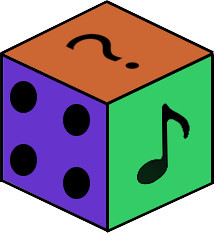This text is not licensed as our standard Creative Commons with derivative works allowed, please do not contribute to it.
One might actually begin anywhere in Wolff's Prose Collection to discuss the use of prose in music scores. Though unassuming in appearance and rhetoric the collection represents an impressive array of writing strategies and of the kinds of music that can emerge from them. One of the characteristics of this music generally is that you do not really find out how the score functions until you try it out. The kind of reading one does for sense is obviously very different from the kind of reading one does when one has to act upon instructions.
For instance, with Fits and Starts when you get to the end of your first reading, you may have to reread in order to remember that you have to begin with only four or five of the six sequences. This implies coordination amongst the members of the ensemble in order to work out which sequences will be represented. If one has, say, three performers, the implication will be that at least one of the performers must switch from one sequence to another near the start of the piece; if one has 20 players, the group will have to decide which sequence (or two sequences) will not be available. In trying out the sequences themselves, it might become clear to a performer that they will need to write out the numbered pulse points in order to keep track of an involved counting procedure […].
One is sent back to the score again and again, in order to sift through all of the information necessary to stay within the boundaries of the piece. One will also have to read carefully to understand what has not been defined. For instance, what in this piece is a 'sound'? Nothing is said about this until the fourth sentence, and here it concerns only the parameter of duration. There are actually a few options in considering duration, the simplest being a sound lasting no more than 2.5 seconds, as a marker of the pulse. But the duration of the sound can also be (much) longer, which in this case becomes a carrier for the pulse. now understood as an 'articulation'.
Nothing at all is said about the instrument, pitch, colour or indeed the character of sound to be used. It might be almost anything, produced in just about any way, at any volume, at any pitch or without pitch altogether and so forth. In rehearsal one will probably make a whole chain of adjustments to the sound as one's sense of the realization develops. It is only after one has worked on the piece for a while that it becomes possible to understand what is meant by the last, most elusive sentence of Wolff's text — his permission to leave the instructions behind in order to proceed according to the music of one's own rhythms.
The result, when everything goes right, can be unlike anything one has heard before: a layering of individual pulses, making organically complex pattern that, in spite of their extreme polyrhythmic complexity, can sound quite natural, even gentle.
This somewhat lengthy summary of the procedure of working on the piece is an attempt to demonstrate just how close the reading of the score will be, and to give something of the flavour of the readings to which the piece has to submit. Working on this kind of music, I sometimes have the feeling that I am reading a legal document (the US Constitution?), and trying, as would a judge or legal scholar, to reach a settled interpretation of the score. Should one read for intent, attempting to glean 'spirit of the piece', or does one take the language more rigidly, doing only what is clearly stated? The method used might vary from piece to piece. In any event, with committed performers, there will always be different ways of reading the text and various ideas about what to do with it. This sets a singular chain of events in motion that will, eventually, become woven into the performance itself. Each time I rehearse one of these pieces with a performing group, I am reminded of Wolff's skill in creating prose that stands up to repeated analytical and practical reading. This kind of writing clearly informs a lot of Wolff's other work as well — when prose is used in combination with Wolff's other notational practices.
Another feature of these prose pieces is that nearly anyone can do them. The entry level, in terms of the amount of previous musical training or technique one might need to perform it, is, compared to most classical music, quite low. It is usually possible to use sound sources that are available to just about anyone: the voice, everyday objects or some kind of simple instrument. The score also makes it possible, in most cases, to produce music right away.
This text is part of an article Writing, Music, written by Michael Pisaro for The Ashgate Research Companion to Experimental Music (2009). Entered here with a kind permission from the author. The full article covers all the diverse ways of writing down experimental pieces of music.
Unlike many texts in the wiki, this one should not be edited. If you see a typo or have suggestions, please write in the comments.
See also: Stones — a piece from Christian Wolff's Prose Collection included in the library.
If you think anything should be added to this subpage, please drop a hint or a link for future editors.
